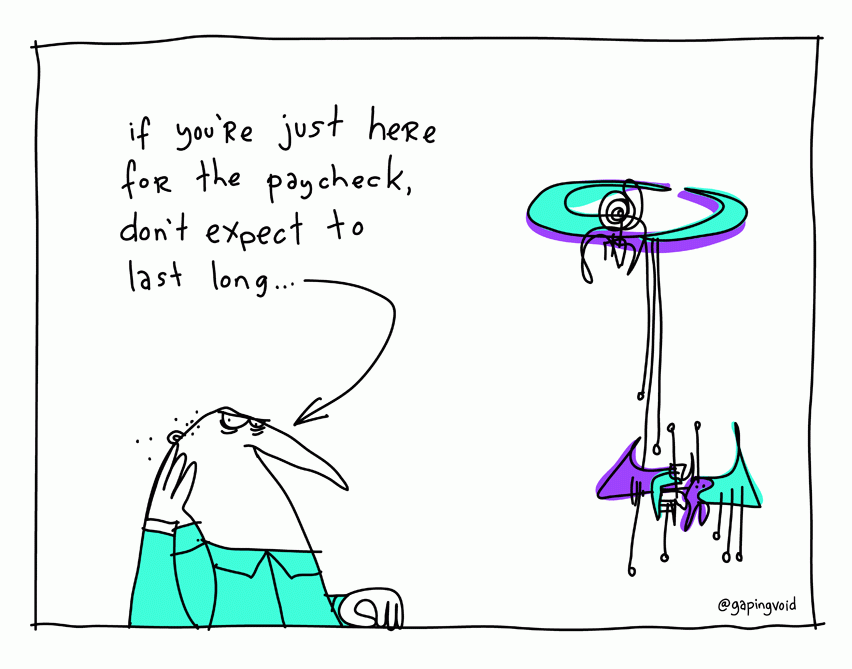Despite several posts on ‘culture‘, of the four Ps I’d mentioned in the Agile @ Scale post, ‘People’ is a topic that has gotten the least attention here in the recent past. As the change imperative forces organisations to be more responsive to rapidly changing external dynamics, the structures, processes and methods it had adopted for its internal stakeholders will most likely have to change as well. Jobs in earlier era were well defined constructs, but this era requires employees to work far beyond their job description in order to thrive. (“Why We Need to Change the Software in our Organisations“) It is probably not a coincidence that the four organisations that are defining the larger contours of business and technology are also the most favoured employers.
The task is not easy. On one hand, there is a workforce that is increasingly getting overwhelmed by communication technologies that are dictating an always-on culture. (“Why you hate work.”) On the other hand, there is a new generation entering the workforce that has expectations of a culture tuned to their lifestyle and ways of functioning. They rapidly disengage if they feel this is no happening. In both cases, the end result is a loss in productivity. This is only one part of the story. There are several factors that define culture, and in an organisation, there are several factors that resist change as well. How does an organisation adapt to these dynamics? A few thoughts, some strategic, some tactical.
Togetherness: ‘The need to belong to something that matters‘ is a Gaping Void phrase I have used before. I think it exists in all humans, sometimes consciously, sometimes in a latent form. The ideas of brand as a platform and social business are perhaps rooted in this. When people working in an organisation are bound by a common purpose, a job transforms into work and I think the employee’s motivation becomes more intrinsic than extrinsic. This would happen when the purpose of the organisation goes beyond the transactional plane. While togetherness could stem from the purpose itself, it could also be based on how the organisation actually goes about achieving it.
Trust & Transparency: If an organisation is driven more by purpose than process, I think the scope for autonomy is much higher. I came across two examples in the hotel industry recently – the $2000 discretionary budget per guest that every Ritz Carlton employee has (via) and Hilton Worldwide’s 100+ employees on Twitter. (via) The common factor in both cases is the trust in the employee’s judgment and intent. On the flip side, the employee needs to trust that the organisation will do what’s best both from a business standpoint as well as the employee’s own career. An employee who has the skill set to make a correct judgment call in a fluid business landscape and has the autonomy to do so – one would think that s a necessity for the organisation.
One of the tactical devices I see becoming increasingly irrelevant is the time spent at work. In most workplaces, I think it’s time to replace the measurement parameters from output to outcome. I put this in the context of trust because the inherent belief is that the employee will get the job done irrespective of where he/she is without being monitored physically.
Technology: Internal collaboration tools and their potential is something we discuss often, it can also be useful in collecting and acting on real time feedback, but let’s take a look beyond that. In what I thought was a fantastic application of big data in this context, (even before the term became hot) Google, in 2009, had used an algorithm to find out which of its employees were likely to quit. Recently they were trying to answer if working at Google increased people’s life span! But the point is that while the world is racing to understand consumers to pitch their products/services better, it might be a good idea for ‘Human Resources’ to use data to truly understand the resources they are dealing with. Of course, there are privacy and ethics challenges involved, but if the organisation is transparent about it, and the intent is clear, it would be useful for everyone concerned. ( I could link it to the LinkedIn & Labour post)
Increasingly, culture is being seen as a strategic business advantage. Some organisations are so serious about this that they have tryouts that go far beyond the standard recruitment procedures. On the other side, maybe there is some onus on the workforce as well – to actively seek and encourage organisations that embrace values they can connect with. Hugh McLeod already said what needed to be said with this –

P.S. I think one of the best works on this subject is something Gautam made in 2010 – The Social Business Employee Manifesto. Do take a look

One thought on “Culture Architecture”